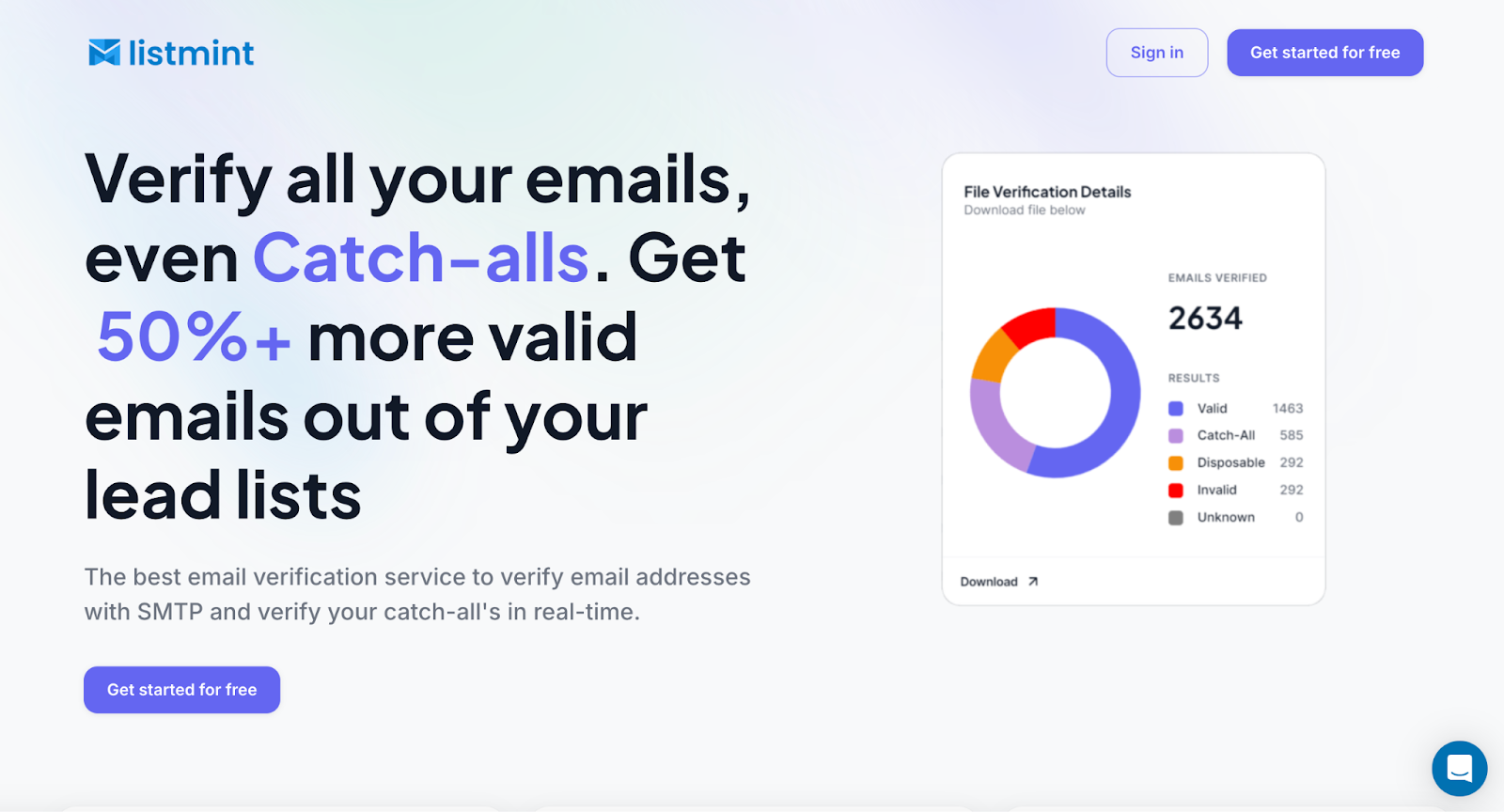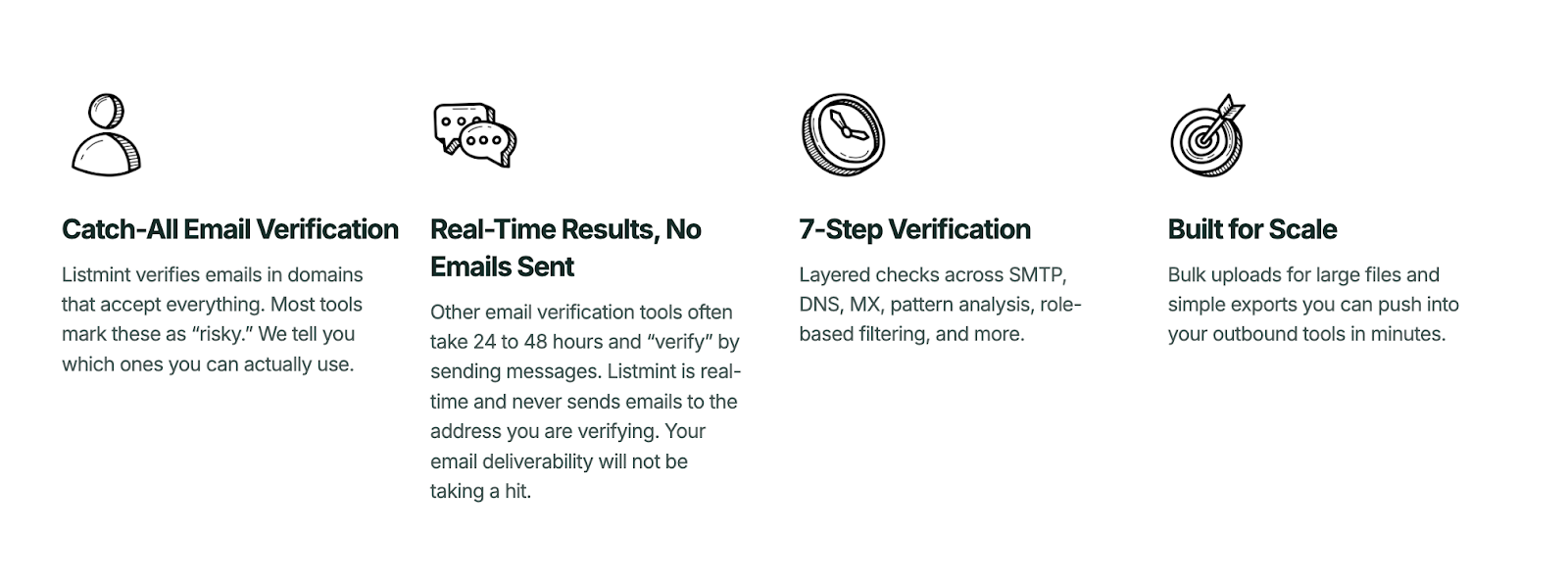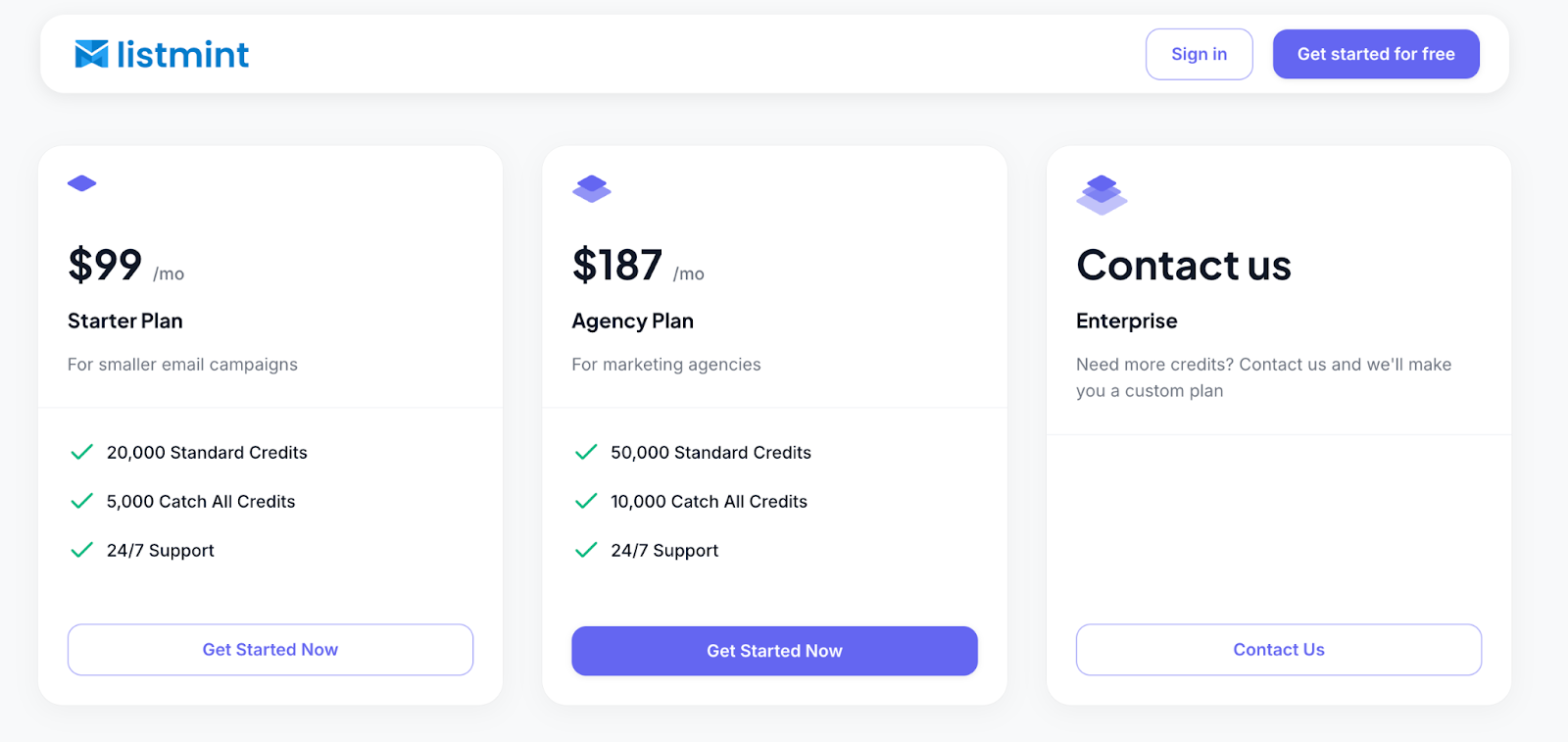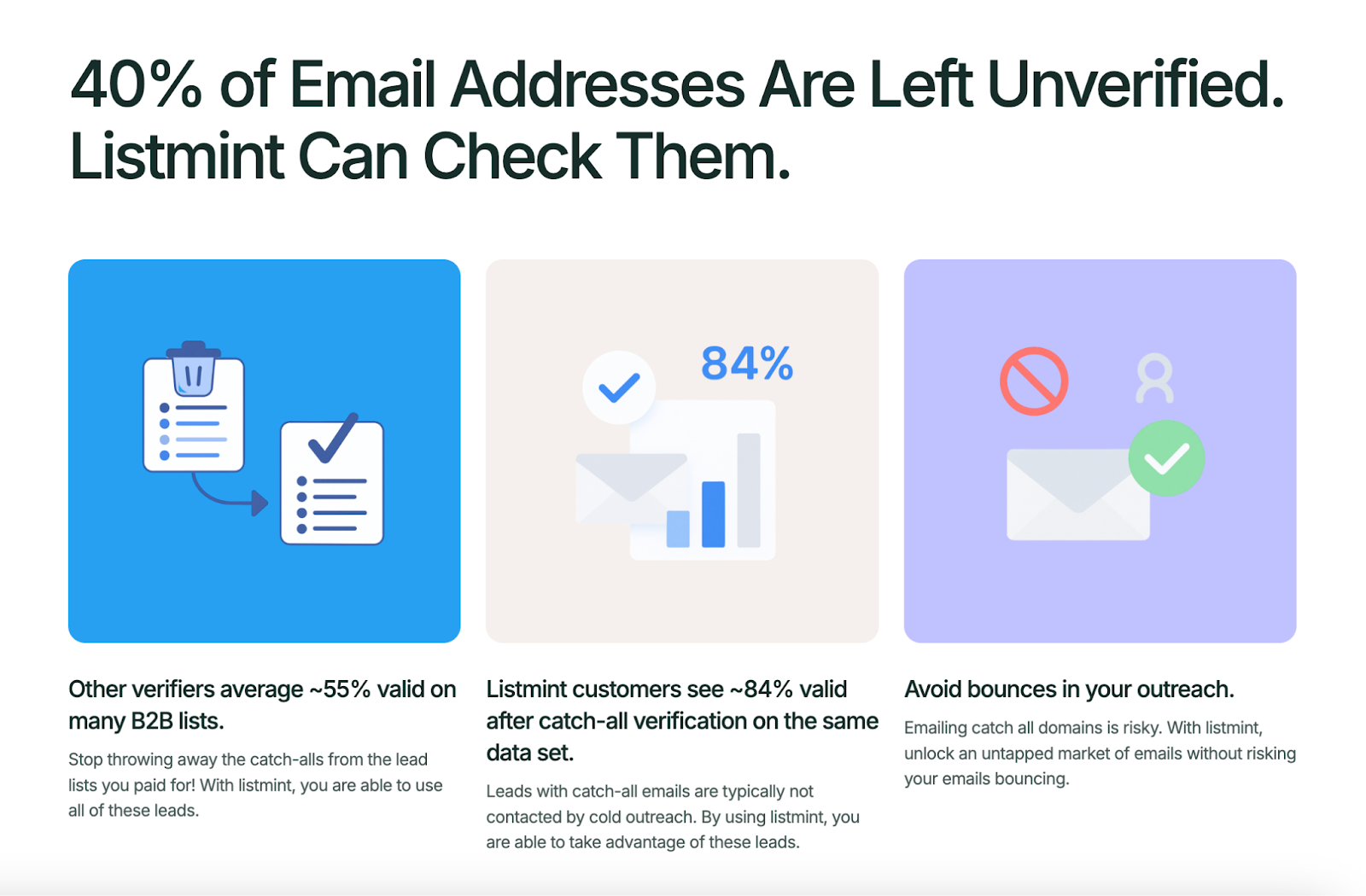
Catch-all verification is one of the most overlooked ways to obtain valuable contacts from your lead list. Many sales and marketing teams remove catch-all email addresses from outreach because standard verification tools flag them as risky.
The problem? Those addresses often belong to real people who could become paying customers.
Catch-all configurations are common across B2B datasets. Many domains accept all email, and a meaningful share of addresses on a typical list come from these domains.
Without a reliable email verification service that includes advanced catch-all email verification, you risk throwing away your potential leads, lowering delivery rates, and hurting your sender reputation.
The right email validation tool helps you identify valid addresses, keep bounce rates low, and recover more leads for small cold email campaigns or large-scale bulk email verification.
This guide will explain what catch-all domains are, why they exist, how to verify catch-all emails safely, and the tools and processes you need to protect email deliverability while getting more value from the data you already have.
A catch-all domain is an email server configuration that accepts all messages sent to any address under that domain, even if the specific mailbox does not exist. For example, both sales@company.com and randomname@company.com would be accepted by the same server.
Companies use this setup to make sure no communication is lost. It allows them to capture inquiries even when a sender mistypes the address, keeps outdated addresses functional, and still routes messages when a recipient is out of the office.
While this setup benefits the receiving business, it creates a challenge for marketers and sales teams. Standard Simple Mail Transfer Protocol (SMTP) validation cannot confirm whether a specific mailbox on a catch-all domain is active.
As a result, these addresses are often flagged as “risky emails” and removed from email campaigns because it’s impossible to confirm mailbox validity with a basic SMTP check. This is where catch-all verification comes in.
Catch-all verification is the process of determining if an email address on a catch-all domain is actually valid and able to receive messages.
Since SMTP validation alone cannot confirm this, the process uses additional checks to separate real contacts from invalid ones, reducing bounce rates and protecting sender reputation.
With SMTP validation, the verification tool pings the email server and checks if the email exists and the mailbox is active. This works for standard domains, but catch-all servers always respond “yes,” even for non-existent addresses, making the result unreliable.
Catch-all email verification uses more advanced methods to go beyond the initial server response.
A “valid” catch-all result means the address has passed multiple verification checks and is likely to accept emails. While it does not guarantee a reply, it confirms the address is not known to be invalid or a spam trap.
In practical terms, this allows teams to confidently add more verified email addresses to their lead list, reach more potential leads, and protect their domain reputation.
For example, a verified catch-all might be a prospect’s primary Google Workspace address used by a real person that would have been discarded without verification.
Verify catch-all emails in real time with Listmint. Sign up for free to get started.
Many businesses set up catch-all addresses to avoid missing important messages by centralizing misaddressed emails in a catch-all inbox. These addresses act as a safety net, catching any email sent to the domain, even if the address doesn’t exist.
While these benefits are valuable for the receiving business, they also create challenges for marketers and sales teams trying to run email campaigns.
Without accurate catch-all verification, risky emails can increase bounce rates, lower email deliverability, and negatively impact sender reputation.
For marketers and sales teams, sending to unverified catch-all addresses can be risky. Verification helps you protect deliverability, keep your sender reputation healthy, and capture more qualified leads.
A Hunter.io study of 2,572 email domains found that around 38% are configured as accept-all or catch-all, meaning they accept messages sent to any address, even if that address does not exist.
For teams running email campaigns, ignoring these contacts can mean losing a significant portion of potential leads.
Catch-all email servers often accept all messages initially, but later reject emails sent to invalid or unknown addresses. This “accept now, bounce later” behavior can mask problems until after campaigns are sent, making it harder to spot bad data and harming overall deliverability.
Sending to unverified catch-all email addresses can lead to high bounce rates, low engagement, and eventual domain reputation damage. This can impact inbox placement and long-term campaign performance.
A clear workflow helps most teams add more valid emails while keeping delivery rates high. Here is a practical process you can run in-house or through an email verification tool.
Before sending a single verification request, remove obvious risks. This upfront cleanup reduces wasted server pings, speeds up processing, and prevents low-quality data from slipping into your CRM. Think of it as clearing the runway before the real work begins.
From here, you can move forward with either bulk verification for list cleanup or API checks for real-time validation at the point of capture.
Once the list is clean, the system moves to active checks. This is where the mail server conversation starts. An SMTP handshake opens a connection to the recipient’s server, asking if the address exists.
With catch-all domains, the server accepts any address, so a basic handshake alone won’t provide certainty.
These layered checks lower the risk of false positives and give a clearer read on whether a domain is truly catch-all or just temporarily accepting mail.
Once all checks are complete, each email address gets a score that reflects how safe it is to send to.
Addresses are sorted into clear status groups so you can act with confidence:
With scoring in place, you can set clear sending rules, protect domain reputation, and focus your outreach on contacts that are worth the effort.
Verification is only valuable if it’s connected to the way you send. The goal is to make sure clean data flows directly into your campaigns without extra manual work.
Start by mapping your verified lists or API checks into your email platform or CRM. Making sure that only approved addresses move forward. For ongoing capture, link verification to your lead forms so every new record is checked before it enters your database.
Key actions to focus on:
When verification is part of the daily workflow, you protect sender reputation, reduce bounce rates, and keep every campaign performing at its best because accuracy and timing matter.
Verification is not a one-time task, so don’t skip periodic checks. Data quality can slip fast if it’s not checked regularly, especially with limited oversight.
Keeping an eye on performance helps you spot issues early and take action before they affect deliverability and how often your emails land in the inbox.
Set up reporting that tracks bounce rates, spam complaints, and engagement across each send. Look for patterns in domains, segments, or acquisition sources that produce more problems than others.
This information will help you adjust your capture process and verification rules.
What to watch each week:
Making monitoring part of the routine guarantees that your verification process keeps working and your lists stay healthy for every campaign.
Listmint does all this for you in real time. Get started now to learn how.

Listmint verifies standard and catch-all emails in real time. Results appear instantly in the app and through the API, with no test emails sent and no 48-hour wait. Your team can use the catch-all segment right away and move clean contacts into active email campaigns.
Scale and accuracy are proven. Listmint has verified 1B+ emails and reports 99%+ accuracy on both SMTP and catch-all checks. Teams keep bounce rates low and protect domain reputation across ongoing outreach.

Customers also report a stronger list yield. Users see up to 84% validity after verification compared to about 55% with other verifiers, plus sub-1% bounce rates on campaigns. That shift turns ignored catch-all addresses into contacts you can actually use.

⭐⭐⭐⭐⭐
“The fastest, easiest, and most effective validation tool. SMTP + Catch-all validation in one platform, the most cost-effective and fastest way to get as many emails validated as possible."
— Matt Lucero, Founder at Anevo Marketing

⭐⭐⭐⭐⭐
“Perfect software for email verification. The best thing about Listmint is soft and hard (catch-all) email verification in one tool, so we do not need separate tools anymore."
— Rens M., Founder at MERKX Agency

Listmint gives your team a faster path to more valid emails without buying more data. You get accurate results, clear statuses, and a workflow that fits daily outreach. Get started for free.

Verifying catch-all emails is one of the most important steps in maintaining healthy email lists and keeping campaigns on track.
Without proper checks, you risk sending messages to addresses that don’t reach the intended recipient, which can harm deliverability and decrease engagement rates.
A reliable email validation service can help you turn a catch-all lead list into a source of verified, high-value contacts.
With options like bulk email verification upload, single email verification, and API integration, you can validate emails and keep all the messages you send accurate and effective.
Listmint makes this simple. You get real-time results for standard and catch-all emails, with no test emails sent and no 48-hour wait.
The platform and API deliver 99%+ accuracy at scale, so your team can move cleaned contacts into active campaigns and see better engagement rates.
Create your free account today and see how fast and accurate verification can improve your next email marketing campaign!
A catch-all domain is an email server setup that accepts all the emails sent to any address at that domain, even if the mailbox does not exist.
This “accept all emails” behavior makes standard checks tricky, so an email validation service applies extra tests before clearing these addresses in your email lists.
Catch-all emails should be verified before every major campaign or at least once every three months. Regular verification keeps your lists current, reduces bounce rates, and maintains a consistent sender reputation over time.
Yes. Advanced catch-all verification tools include spam-trap detection checks. These identify suspicious or inactive addresses hidden in lists, helping teams avoid traps that could lower deliverability scores.
Tools like Listmint verify both standard and catch-all emails in real time with over 99% accuracy. They help marketing and sales teams confirm valid addresses instantly, reduce bounces, and maintain clean, reliable contact lists.
Verify all your emails, even Catch-alls in real-time with our Email Verification Software.
Create an account for free.